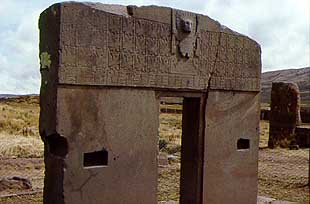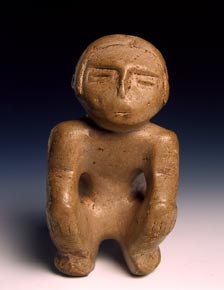Archeological Discoveries in Peru
Home » Articles and News » Archeological Discoveries in Peru
by Hortense Soulier
One of the most beautiful countries in South America, boasting a unique and heavy history, Peru is home to myriad fascinating archeological sites which help us understand earlier civilizations, form the Incas in the 15th century to cultures thousands of years ago. Every year, Peru sees new archeological discoveries which shed light on these cultures and help solve decade-long mysteries on how the ancient people lived. History and archeology buffs will find their dream come true as they explore Peru and its countless sites. Recent discoveries are already bringing new insights into Peru’s history.
 In July 2010, an unexpected discovery was to give the archeological world great insights into the unfamiliar and very ancient Wari culture. While excavating the Inca site of Espiritu Pampa in Vilcabamba, a small town located in the Sacred Valley, archeologist Noe Huaman found interesting and odd objects which did not seem to belong to the Incas. The axe blades, earthen pot and jewelry pieces that were found actually belonged to the Wari culture, and their study over the past year has just resulted in February 2011 in a presentation bringing fascinating new information about the lives of the Wari people.
Around the same time in northern Peru, another lucky archeologist stumbled across the bones of several persons from pre-Inca civilizations, believed to be over 1,200 years old. After careful observation, the bones of these 20 people were found to belong to the ancient Sicán Culture, Pre-Inca Culture also known as “Lambayeque Culture”, settled down in the north coast, Pomac was its cultural center (Batán Grande), located in Lambayeque, near to Chiclayo. The Sican people lived around 700 to 1375 A.D., before vanishing after the Chimu conquest. Some of the bones were found in a certain type of sarcophagus and wi
In July 2010, an unexpected discovery was to give the archeological world great insights into the unfamiliar and very ancient Wari culture. While excavating the Inca site of Espiritu Pampa in Vilcabamba, a small town located in the Sacred Valley, archeologist Noe Huaman found interesting and odd objects which did not seem to belong to the Incas. The axe blades, earthen pot and jewelry pieces that were found actually belonged to the Wari culture, and their study over the past year has just resulted in February 2011 in a presentation bringing fascinating new information about the lives of the Wari people.
Around the same time in northern Peru, another lucky archeologist stumbled across the bones of several persons from pre-Inca civilizations, believed to be over 1,200 years old. After careful observation, the bones of these 20 people were found to belong to the ancient Sicán Culture, Pre-Inca Culture also known as “Lambayeque Culture”, settled down in the north coast, Pomac was its cultural center (Batán Grande), located in Lambayeque, near to Chiclayo. The Sican people lived around 700 to 1375 A.D., before vanishing after the Chimu conquest. Some of the bones were found in a certain type of sarcophagus and wi th characteristic items which indicate they belong to one of the leaders of the Sican culture.
In October 2010, an entire funerary complex comprising nine graves was also discovered, although its age has yet to be determined. The amazing discoveries show that the influence of the Wari culture in pre-Hispanic times was a lot more important than what was originally believed by historians and archeologists.
Another incredible find occurred in February 2011, when a major temple of the Mochica culture was discovered in the Lambayeque region. Many tombs from ancient Peruvian cultures of pre-Hispanic times dating back to 1500 BC were also excavated in the area. This is only one of the many surprises that the region holds in store for us. With several ongoing excavating projects, we are sure to witness new fascinating discoveries that will greatly contribute to understanding the history of enchanting Peru.
To appreciate the Mochica art in their invaluable ceramic pieces, textiles, you can go to the Archaeological museums of Peru, Larco Herrera, de la Nacion in Lima and the Museo Brüning in Lambayeque. The extensive archaeological collection in this museum includes more than 100,000 items from pre-Hispanic cultures including ceramics, metals, funeral offerings and carved stone figures.
th characteristic items which indicate they belong to one of the leaders of the Sican culture.
In October 2010, an entire funerary complex comprising nine graves was also discovered, although its age has yet to be determined. The amazing discoveries show that the influence of the Wari culture in pre-Hispanic times was a lot more important than what was originally believed by historians and archeologists.
Another incredible find occurred in February 2011, when a major temple of the Mochica culture was discovered in the Lambayeque region. Many tombs from ancient Peruvian cultures of pre-Hispanic times dating back to 1500 BC were also excavated in the area. This is only one of the many surprises that the region holds in store for us. With several ongoing excavating projects, we are sure to witness new fascinating discoveries that will greatly contribute to understanding the history of enchanting Peru.
To appreciate the Mochica art in their invaluable ceramic pieces, textiles, you can go to the Archaeological museums of Peru, Larco Herrera, de la Nacion in Lima and the Museo Brüning in Lambayeque. The extensive archaeological collection in this museum includes more than 100,000 items from pre-Hispanic cultures including ceramics, metals, funeral offerings and carved stone figures.
 In July 2010, an unexpected discovery was to give the archeological world great insights into the unfamiliar and very ancient Wari culture. While excavating the Inca site of Espiritu Pampa in Vilcabamba, a small town located in the Sacred Valley, archeologist Noe Huaman found interesting and odd objects which did not seem to belong to the Incas. The axe blades, earthen pot and jewelry pieces that were found actually belonged to the Wari culture, and their study over the past year has just resulted in February 2011 in a presentation bringing fascinating new information about the lives of the Wari people.
Around the same time in northern Peru, another lucky archeologist stumbled across the bones of several persons from pre-Inca civilizations, believed to be over 1,200 years old. After careful observation, the bones of these 20 people were found to belong to the ancient Sicán Culture, Pre-Inca Culture also known as “Lambayeque Culture”, settled down in the north coast, Pomac was its cultural center (Batán Grande), located in Lambayeque, near to Chiclayo. The Sican people lived around 700 to 1375 A.D., before vanishing after the Chimu conquest. Some of the bones were found in a certain type of sarcophagus and wi
In July 2010, an unexpected discovery was to give the archeological world great insights into the unfamiliar and very ancient Wari culture. While excavating the Inca site of Espiritu Pampa in Vilcabamba, a small town located in the Sacred Valley, archeologist Noe Huaman found interesting and odd objects which did not seem to belong to the Incas. The axe blades, earthen pot and jewelry pieces that were found actually belonged to the Wari culture, and their study over the past year has just resulted in February 2011 in a presentation bringing fascinating new information about the lives of the Wari people.
Around the same time in northern Peru, another lucky archeologist stumbled across the bones of several persons from pre-Inca civilizations, believed to be over 1,200 years old. After careful observation, the bones of these 20 people were found to belong to the ancient Sicán Culture, Pre-Inca Culture also known as “Lambayeque Culture”, settled down in the north coast, Pomac was its cultural center (Batán Grande), located in Lambayeque, near to Chiclayo. The Sican people lived around 700 to 1375 A.D., before vanishing after the Chimu conquest. Some of the bones were found in a certain type of sarcophagus and wi th characteristic items which indicate they belong to one of the leaders of the Sican culture.
In October 2010, an entire funerary complex comprising nine graves was also discovered, although its age has yet to be determined. The amazing discoveries show that the influence of the Wari culture in pre-Hispanic times was a lot more important than what was originally believed by historians and archeologists.
Another incredible find occurred in February 2011, when a major temple of the Mochica culture was discovered in the Lambayeque region. Many tombs from ancient Peruvian cultures of pre-Hispanic times dating back to 1500 BC were also excavated in the area. This is only one of the many surprises that the region holds in store for us. With several ongoing excavating projects, we are sure to witness new fascinating discoveries that will greatly contribute to understanding the history of enchanting Peru.
To appreciate the Mochica art in their invaluable ceramic pieces, textiles, you can go to the Archaeological museums of Peru, Larco Herrera, de la Nacion in Lima and the Museo Brüning in Lambayeque. The extensive archaeological collection in this museum includes more than 100,000 items from pre-Hispanic cultures including ceramics, metals, funeral offerings and carved stone figures.
th characteristic items which indicate they belong to one of the leaders of the Sican culture.
In October 2010, an entire funerary complex comprising nine graves was also discovered, although its age has yet to be determined. The amazing discoveries show that the influence of the Wari culture in pre-Hispanic times was a lot more important than what was originally believed by historians and archeologists.
Another incredible find occurred in February 2011, when a major temple of the Mochica culture was discovered in the Lambayeque region. Many tombs from ancient Peruvian cultures of pre-Hispanic times dating back to 1500 BC were also excavated in the area. This is only one of the many surprises that the region holds in store for us. With several ongoing excavating projects, we are sure to witness new fascinating discoveries that will greatly contribute to understanding the history of enchanting Peru.
To appreciate the Mochica art in their invaluable ceramic pieces, textiles, you can go to the Archaeological museums of Peru, Larco Herrera, de la Nacion in Lima and the Museo Brüning in Lambayeque. The extensive archaeological collection in this museum includes more than 100,000 items from pre-Hispanic cultures including ceramics, metals, funeral offerings and carved stone figures. Home » Articles and News » Archeological Discoveries in Peru
